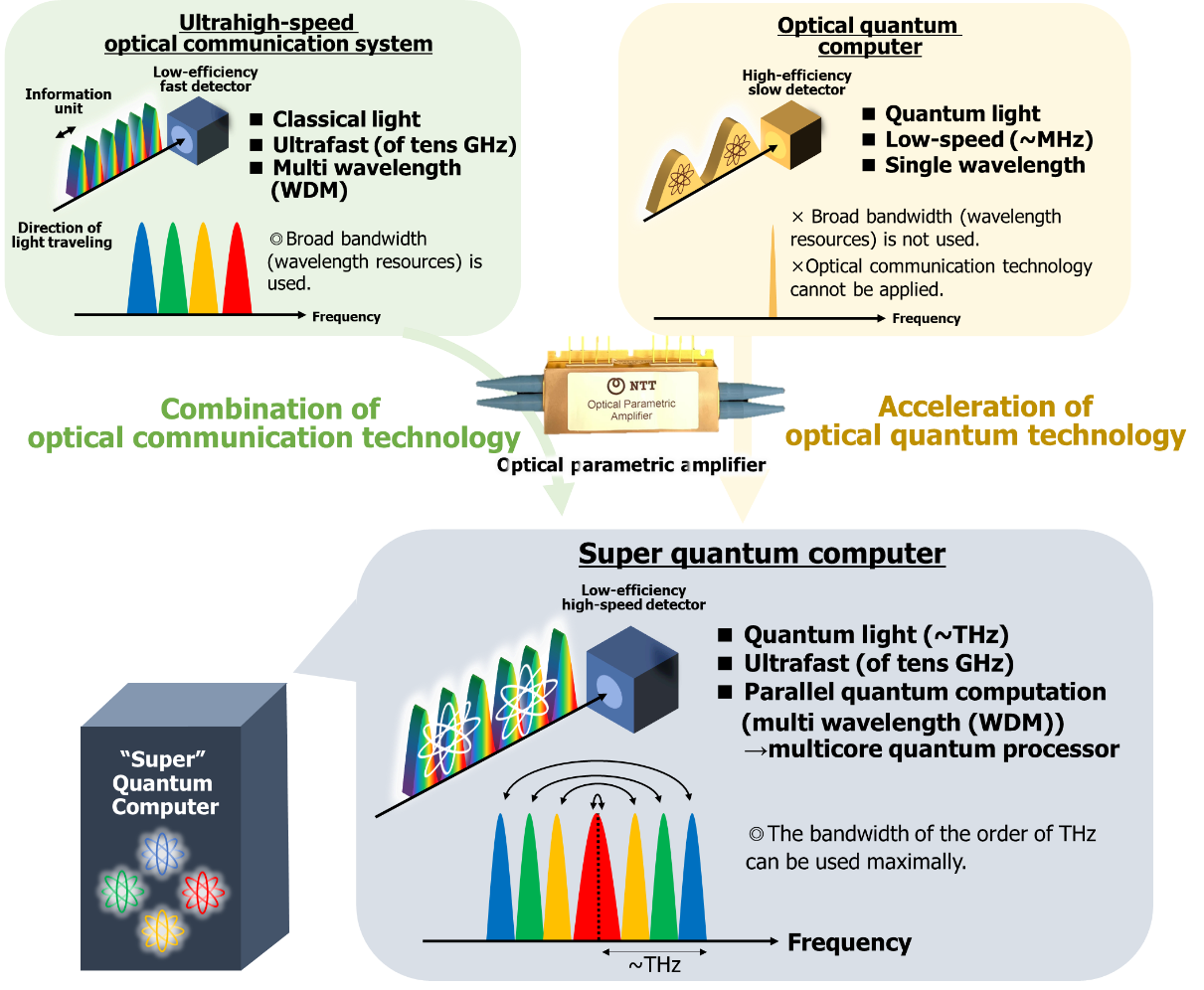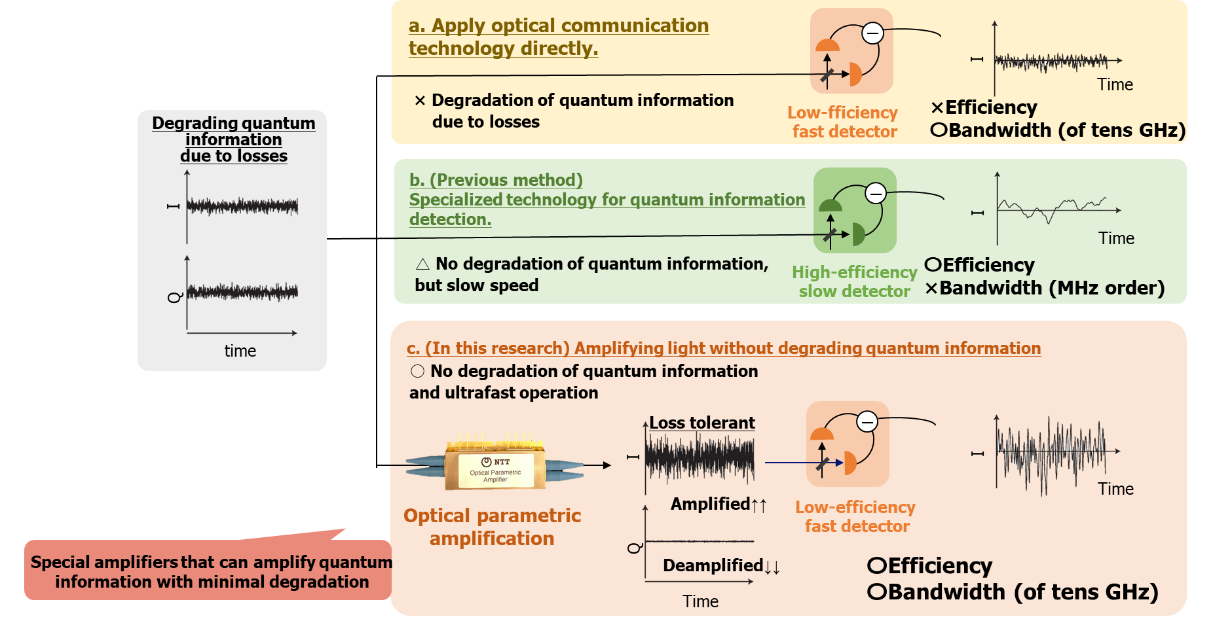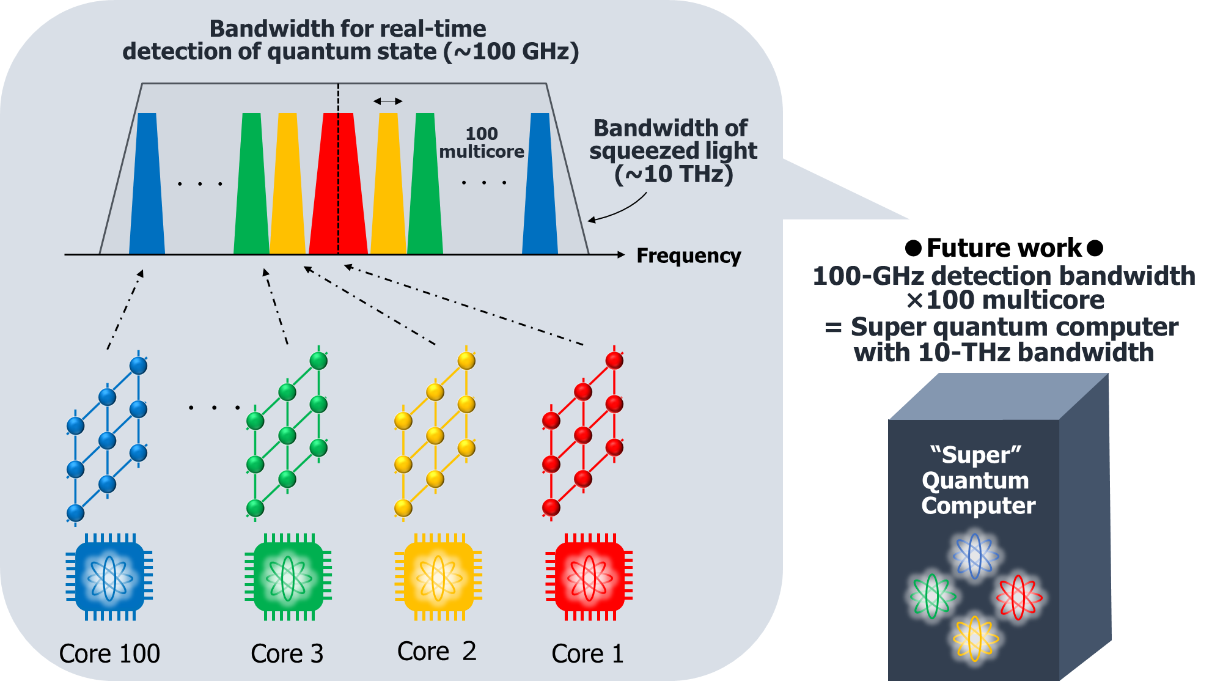Microsoft ends support for Internet Explorer on June 16, 2022.
We recommend using one of the browsers listed below.
- Microsoft Edge(Latest version)
- Mozilla Firefox(Latest version)
- Google Chrome(Latest version)
- Apple Safari(Latest version)
Please contact your browser provider for download and installation instructions.
March 6, 2023
43-GHz real-time optical quantum signal detection for ultrafast quantum computation
Toward super quantum computers with optical high-speed communication technologies
【Abstract】
Nippon Telegraph and Telephone Corporation (NTT, President & CEO: Akira Shimada, Chiyoda-ku, Tokyo) in cooperation with the University of Tokyo (President: Teruo Fujii, Bunkyo-ku, Tokyo) and the Institute of Physical and Chemical Research (Riken, President: Makoto Gonokami, Wako-shi, Saitama) has developed a new technology for applying commercial optical communication technology, as represented by 5G, to optical quantum technology. Thanks to this technology, 43-GHz real-time quadrature amplitude measurement, which is the world's fastest record, has been successfully achieved using an ultrafast detector for an optical communication system.
This achievement leads to a paradigm shift from the classical computer development stream, which is based on space-division multiplexing and chip integration by nanotechnology, to the ultrafast optical communication system development stream, which utilizes wavelength and temporal resources.
This technology not only contributes significantly to the realization of high-speed quantum computation operating at clock frequencies above 10 GHz (*1) but also enables multi-core optical quantum computer processors without changing the size of the equipment by using wavelength division multiplexing (WDM) technology, which is one of the recent ultrafast optical communication technologies (*2). In the future, we aim to achieve a super quantum computer with the speed of 100-GHz clock frequency and the parallelism of 100 quantum processors.
The results of this research were published in the American scientific journal Applied Physics Letters on March 6, 2023. A part of this research was supported by the Japan Science and Technology Agency (JST) Moonshot Research and Development Program.
 Figure 1. The proposed super quantum computer with multi-core quantum processors operating at clock frequencies of tens of GHz. The super quantum computer can be realized by combining ultrafast optical communication technology (e.g., 5G) and optical quantum computer technology.
Figure 1. The proposed super quantum computer with multi-core quantum processors operating at clock frequencies of tens of GHz. The super quantum computer can be realized by combining ultrafast optical communication technology (e.g., 5G) and optical quantum computer technology.
【Points】
- A new technology has been developed to speed up optical quantum computers by combining optical quantum processors with ultrafast optical communication technologies (5G technologies), in which enormous capital investment and technological accumulation have been made.
- The developed optical parametric amplifier makes it possible to apply high-speed detectors for quantum signal measurements. As a result, real-time quantum signal measurement in the 43-GHz band, which is the world's fastest bandwidth, was successfully achieved.
- By combining this new technology with wavelength division multiplexing (WDM), which is one of the 5G technologies, a multi-core optical quantum computer can be achieved. Thus, this new technology paves the way for the super quantum computer.
【Background】
Quantum computers can perform large-scale parallel quantum computations that cannot be achieved with conventional classical computers, thus attracting research and development interest around the world. Among various methods proposed, measurement-based (*3) optical quantum computing with time-domain multiplexing techniques (*4) is featured because it can achieve large-scale and high-speed quantum computation. In this method, "flying qubits" whereby the photons fly at light speed are utilized instead of the "standing wave" qubits typical in other quantum computers, and by placing these flying qubits on the time axis, we can achieve large-scale quantum computation without increasing the size of the equipment or the integration of the devices.
Furthermore, this method has an advantage in that it is highly compatible with existing optical communication technologies. Thus, optical quantum computing can utilize reliable and high-performance technology related to optical communication, which has been developed through enormous investment so far. As a result, quantum computation at high clock frequencies can be achieved by utilizing the high-speed communication technologies in 5G and Beyond 5G communication backbone networks.
However, not every high-speed optical communication device can be used as is for optical quantum computers. For example, it is not possible to use high-speed detectors above 100 GHz for optical communications to measure optical quantum signal. This is because high-speed optical communication detectors have high optical losses that degrade the optical quantum information. Therefore, quantum signal measurements have to be carried out using specially designed slow detectors with low optical losses. This is a major limiting factor for clock frequencies in measurement-based quantum computation. Despite our success in generating quantum light in the THz band in 2021 (refs. 2 and 3), we could not utilize the THz band because of this measurement bandwidth limitation.
【Results】
In this study, we developed a new technology for applying ultrahigh-speed optical communication technology to optical quantum technology by utilizing an optical parametric amplifier (*5), which amplifies signal light while retaining the optical quantum information (Fig. 1). This technology has paved the way for super quantum computers to take full advantage of the high-speed and broadband nature of optical technology. As an example, we present a method for measuring signals at high speed using commercially available high-speed telecommunications detectors after optical parametric amplification (Fig. 2). This technology enables optical communication technology to be applied to the optical quantum technology by amplifying optical quantum states to a "classical" level where they are not affected by optical losses. In this experiment, we utilized an optical parametric amplifier based on a direct-bonded periodically poled lithium niobate (PPLN) waveguide (*6) with a high amplification gain (about 3,000 times) and a small signal-to-noise figure (about 20%), which has been researched at NTT for many years (Fig. 3) (Ref. 4). Figure 4 shows the results of amplitude measurements of squeezed light (*7) using a 43-GHz detector for optical communications and a real-time oscilloscope. The histogram of voltage amplitude values indicates that the quantum noise compression ratio is approximately 65%. This value exceeds the minimum quantum noise compression required for optical quantum computing (60%), meaning that faster quantum operations running at 1,000 times higher clock frequencies than with conventional technologies can be achieved.
 Figure 2 (a) Low-efficiency, high-speed detection system using conventional high-speed detectors for optical communications. (b) High-efficiency, low-speed detection system using conventional detectors designed for optical quantum applications (c) High-efficiency, high-speed detection system using optical parametric amplification and high-speed detectors for optical communications, as proposed and demonstrated in this research.
Figure 2 (a) Low-efficiency, high-speed detection system using conventional high-speed detectors for optical communications. (b) High-efficiency, low-speed detection system using conventional detectors designed for optical quantum applications (c) High-efficiency, high-speed detection system using optical parametric amplification and high-speed detectors for optical communications, as proposed and demonstrated in this research.
 Figure 3 Fiber-coupled optical parametric amplifier based on a direct-bonded periodically poled lithium niobate (PPLN) waveguide. Used as a "quantum" optical amplifier in this study.
Figure 3 Fiber-coupled optical parametric amplifier based on a direct-bonded periodically poled lithium niobate (PPLN) waveguide. Used as a "quantum" optical amplifier in this study.
 Figure 4 (a) Measurement results using a high-speed detector for optical communications in the 43-GHz band and a real-time oscilloscope. (b) Histogram of voltage values.
Figure 4 (a) Measurement results using a high-speed detector for optical communications in the 43-GHz band and a real-time oscilloscope. (b) Histogram of voltage values.
【Future work】
Our findings indicate that the combination of ultrafast optical communication technology (5G) and optical quantum computer technology will enable high-speed optical quantum computation in the bandwidth of over 100 GHz. Moreover, it will be possible to combine ultrafast optical communication technology, for which enormous investment and technology has been accumulated, with optical quantum processors, thus greatly accelerating the development of optical quantum computers. For example, the use of wavelength division multiplexing (WDM), an optical communication technology, will lead to multi-core quantum processors in the future. These technologies will enable a 100-GHz bandwidth, 100 multi-core super quantum computer with a maximum bandwidth on the order of THz, which will outperform conventional Neumann-type computers in terms of operating speed (Fig. 5).
 Figure 5 Proposed super quantum computer, which can utilize the 10-THz bandwidth of squeezed light by using 100-GHz detection technology, and 100 multicore with wavelength division multiplexing technology, listed as a future prospect.
Figure 5 Proposed super quantum computer, which can utilize the 10-THz bandwidth of squeezed light by using 100-GHz detection technology, and 100 multicore with wavelength division multiplexing technology, listed as a future prospect.
【Support for this research】
This research was supported by the Japan Science and Technology Agency (JST) Moonshot R&D Project, Moonshot Goal 6: "Realization of a fault-tolerant universal quantum computer that will revolutionize economy, industry, and security by 2050" (Program Director: Katsuhiro Kitagawa, Professor, Graduate School of Engineering Science, Osaka University). It was also part of the R&D project "Development of Large-scale Fault-Tolerant Universal Optical Quantum Computers" (Project Manager: Akira Furusawa, Professor, Graduate School of Engineering, the University of Tokyo).
【Comment from project manager】
This method of optical quantum computing requires highly efficient and fast amplitude measurements. Conventional methods have sacrificed high speed for high efficiency. In the new method, the optical parametric amplifier is utilized to amplify the signal as an optical signal so that high efficiency can be achieved without sacrificing high speed. This has enabled the basic technology for the realization of a 43-GHz clocked optical quantum computer. Furthermore, 100 quantum processing cores can be achieved when combined with wavelength multiplexing for optical communications systems. Thus, the realization of a super quantum computer with a 100-GHz clock/100 cores is now possible. As such, this is an extremely innovative achievement.
【Glossary of terms】
*1Clock frequency
One of the index values for expressing processor performance, which indicates how many times per second the signal emitted by the processor can be handled when processing. The higher the clock frequency, the more processing can be carried out in the same amount of time. Current Neumann-type computers have a clock frequency of several GHz.
*2Ultra-high-speed optical communication technology
Optical communication technology utilizing digital coherent technology, large-scale wavelength division multiplexing, etc. used in the backbone networks of NTT and other telecommunications carriers; an essential technology for the backbone networks in 5G and Beyond 5G communications.
*3Measurement-based
Refers to a method that enables operations equivalent to gated quantum operations, which are currently being researched in many countries. Unlike conventional gated quantum computing, where individual qubits are entangled by gated operations, this method prepares a large-scale quantum entanglement in advance and manipulates the remaining qubits by observing others.
*4Time-domain multiplexing technique
A technique for generating large-scale entangled states from a limited number of quantum light sources by dividing the light emitted from a continuous quantum light source in the time domain and interfering with the divided quantum wave packets (pulses) by an optical delay interference system.
*5Optical parametric amplifier.
A technique for amplifying light of a specific wavelength by utilizing non-linear optical effects occurring in a material to cause light of different wavelengths to interact with each other. In principle, it can amplify quantum information without degradation. Highly nonlinear fibers and lithium niobate are known as nonlinear media.
*6Direct-bonded periodic poled lithium niobate (PPLN) waveguide
An optical waveguide consisting of an artificial crystal in which the direction of positive and negative charges, called periodic polarization, is reversed at a certain period in the non-linear medium lithium niobate (LiNbO3). Periodically poled lithium niobate can achieve significantly higher non-linear optical effects than the original lithium niobate crystal.
*7Squeezed light
Light in which one of the quantum fluctuations (quantum noise) in a noncommutative physical quantity pair is compressed. Generally generated using non-linear optical phenomena.
【References】
(Reference 1)
Shuntaro Takeda and Akira Furusawa, "Toward large-scale fault-tolerant universal photonic quantum computing", APL Photonics 4, 6, 060902 (2019)
(Reference 2)
Successful development of core technology for realizing large-scale optical quantum computers in the size of a rack
Novel development of optical fiber-coupled quantum light source
NTT news release, December 22, 2021
https://group.ntt/jp/newsrelease/2021/12/22/211222a.html
(Reference 3)
Takahiro Kashiwazaki, Taichi Yamashima, Naoto Takanashi, Asuka Inoue, Takeshi Umeki, and Akira Furusawa, "Fabrication of low-loss quasi-single-mode PPLN waveguide and its application to a modularized broadband high-level squeezer", Applied Physics Letters 119, 251104 (2021)
(Reference 4)
Takushi Kazama, Takeshi Umeki, Shimpei Shimizu, Takahiro Kashiwazaki, Koji Enbutsu, Ryoichi Kasahara, Yutaka Miyamoto, and Kei Watanabe, "Over-30-dB gain and 1-dB noise figure phase-sensitive amplification using a pump-combiner-integrated fiber I/O PPLN module", Optics Express 29, 18, 28824 (2021)
【Published Paper】
Asuka Inoue, Takahiro Kashiwazaki, Taichi Yamashima, Naoto Takanashi, Takushi Kazama, Koji Enbutsu, Kei Watanabe, Takeshi Umeki, Mamoru Endo, and Akira Furusawa
"Towards a multi-core ultra-fast optical quantum processor: 43-GHz bandwidth real-time amplitude measurement of 5-dB squeezed light using modularized optical parametric amplifier with 5G technology"
Applied Physics Letters
Contact Information
NTT Corporation
Science and Core Technology Laboratory Group, Public Relations
nttrd-pr@ml.ntt.com
Information is current as of the date of issue of the individual press release.
Please be advised that information may be outdated after that point.
NTT STORY
WEB media that thinks about the future with NTT










